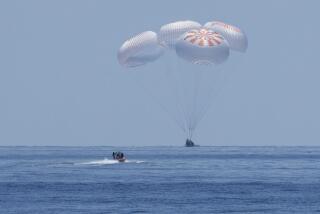A Southern California Blastoff
- Share via
Jubilation is reigning in the Antelope Valley after Vice President Al Gore, on behalf of NASA, announced Tuesday that Palmdale’s Lockheed Martin Corp. will be the chief designer of America’s next generation of space vehicles, the reusable space orbiters. Lockheed Martin will receive $1 billion to design the prototype of a launch vehicle intended to ferry payloads into space much more frequently, reliably and cheaply than the existing space shuttle. Lockheed’s finished product, the X-33, a triangular plane that in sketches looks something like a dull pencil tip, is expected to come into service by 2010.
Officials at Lockheed Martin’s famed “Skunk Works” advanced-design plant are already laying out plans to manufacture the X-33 at Palmdale’s Plant 42, a government facility where the B-2 stealth bombers and other top-secret military planes were designed, and to test and launch the vehicles at nearby Edwards Air Force Base.
This obviously will be a boon to the Southern California economy, even though the big money ($5 billion to $12 billion) won’t arrive until private industry orders begin flowing in after Lockheed’s prototype is completed in 1999.
Private industry demand is sure to be substantial. The American space program’s declaration of its “giant step for mankind” rang loudly across the world during the 1960s and ‘70s, but the X-33 effort is likely to rake in profits undreamed of in those decades. Some industry observers have said that just as railroads spurred industrialization in the 19th century, the reusable launch vehicle program of the 21st century will create cities and industries, opportunities and jobs.
Iridium, for example, a project sponsored by Motorola and other major telecommunications companies, hopes to launch 66 satellites. The Teledesic Corp., founded by Microsoft’s Bill Gates and McCaw Cellular’s Craig O. McCaw, says that it plans to launch 840 satellites largely to offer high-bandwidth computer communication.
Despite the abundant promise of gold, not everyone in the aerospace industry has been waving pompons of good cheer. Last month, the Boeing Corp., which had been helping McDonnell Douglas develop a rival bid to Lockheed Martin’s, exited its partnership because it felt it could not, as NASA had mandated, share some of the financial cost overruns associated with R&D; for the X-33. And NASA chief Daniel Goldin, who has managed to trim the agency’s costs, is facing opposition from the old-time “top gun” military pilots who have long directed the agency. Goldin’s reforms must continue or America may see itself losing market share to foreign competition. All involved should keep in mind the 1970s, when the Japanese found more efficient ways of manufacturing the electronic components that the United States had pioneered, and the ‘80s. U.S. launch firms lost 60% of the world market to such rivals as Ariane-Space of France, and Southern California lost more than 350,000 jobs when the government failed to help aerospace factories retool to serve post-Cold War market needs.
This time, private industry must be willing to shoulder some of the cost overruns likely to be incurred during the development of a truly revolutionary space vehicle. And Congress should not shy away from the bold measures, whether related to leadership or funding, that will be required to meet the high expectations that NASA rightly has set.
More to Read
Inside the business of entertainment
The Wide Shot brings you news, analysis and insights on everything from streaming wars to production — and what it all means for the future.
You may occasionally receive promotional content from the Los Angeles Times.










